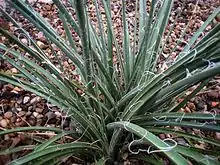Hesperaloe parviflora
Hesperaloe parviflora, also known as red yucca, hummingbird yucca, redflower false yucca and samandoque, is a plant that is native to Chihuahuan desert of west Texas east and south into central and south Texas and northeastern Mexico around Coahuila.[2]
| Hesperaloe parviflora | |
|---|---|
 | |
| Scientific classification | |
| Kingdom: | Plantae |
| Clade: | Tracheophytes |
| Clade: | Angiosperms |
| Clade: | Monocots |
| Order: | Asparagales |
| Family: | Asparagaceae |
| Subfamily: | Agavoideae |
| Genus: | Hesperaloe |
| Species: | H. parviflora |
| Binomial name | |
| Hesperaloe parviflora | |
| Synonyms | |

It has narrow evergreen leaves with a fringe of white threadlike hairs along their edges, and grows in clumps 3–6 ft (0.91–1.83 m) high and wide. Red or yellow tubular flowers are borne on branching flower stalks (inflorescences) up to 5 ft (1.5 m) tall from late spring to mid-summer.[3]
The Latin specific epithet parviflora means "with small flowers".[4]
This species has become popular in xeriscape landscape design for public and private gardens in California and the Southwestern United States. The plant's qualities include drought tolerance, heat resistance, low maintenance needs, hummingbird attracting flowers,[5] and an architectural form. It is also a spineless alternative to Agave and Yucca horticultural species.[6]
References
- "Hesperaloe parviflora". Germplasm Resources Information Network. Agricultural Research Service, United States Department of Agriculture. Retrieved 2010-08-13.
- http://swbiodiversity.org/seinet/taxa/index.php?taxon=17237 Southwest Biodiversity
- http://www.sanmarcosgrowers.com/products/plants/plantdisplay.asp?plant_id=831 San Marcos
- Harrison, Lorraine (2012). RHS Latin for Gardeners. United Kingdom: Mitchell Beazley. ISBN 978-1845337315.
- http://ag.arizona.edu/pima/gardening/aridplants/Hesperaloe_parviflora.html Archived 2009-10-16 at the Portuguese Web Archive University of Arizona
- San Marcos
External links
 Media related to Hesperaloe parviflora at Wikimedia Commons
Media related to Hesperaloe parviflora at Wikimedia Commons Data related to Hesperaloe parviflora at Wikispecies
Data related to Hesperaloe parviflora at Wikispecies